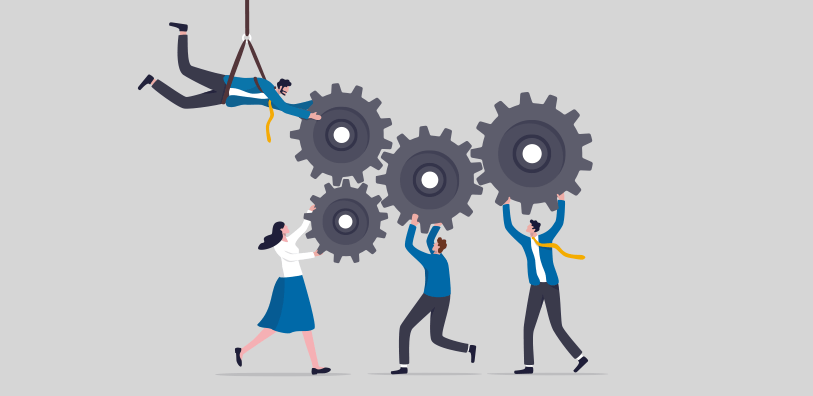
Click the button to start reading
Top 7 Ways To Build Capability In A Team (and the top training methods!)
Company culture has become the driving force of the corporate world, and building a capable team is leading the charge. Employees are searching for companies that want to invest in them as a professional, and value the skills they bring to their workplace. While turn-over rates are at an all-time high, now may be the time to consider how you can increase employee morale and boost employee retention.
The answer is in team capability building!

What Is Capability Building?
In short, capability building is when a manager takes steps to further develop the knowledge and skill base of their team members. There are a variety of ways to do this with some being more popular than others (more on this below). Ultimately, your use will vary based on: the employee, their current skills, their long-term goals, and their individual learning style.
Including capability building in your workplace framework serves four main purposes:
- Helping the company meet their future needs
- Aiding in the growth and success of the company long-term
- Developing employee potential
- Promoting growth from within the company
While these are four big reasons for companies to adopt capability building into their work culture, there are a range of other benefits that have made it a highly valued practice in the modern workplace.

What Are The Benefits Of A Capable Team?
A company that has invested in developing highly capable teams find higher rates of success in their industry and run more efficiently than their counterparts. This alone makes capability training desirable; however, there are many other ways it can benefit your company. Some of the most notable include:
- Fostering a collective responsibility among team members
- Providing continual growth for your employees
- Developing a highly skilled workforce
- Increasing performance of the company as a whole
- Creating a healthier work environment
- Improving employee satisfaction rates
- Building stronger working relationships between employees and managers
- Reducing employee turnover rates by promoting growth from within, naturally increasing long-term employee retention
The benefits of cultivating a workplace that prioritizes employee growth are undeniable and have been at the forefront of many modern corporations’ achievements. How a company implements capability building within its company plays a vital role in its success. While there are many ways to adopt this practice, there are seven things you should include when developing your capability training program to find maximum success.

Seven Elements To Include In Your Capability Building Program
Implementation is one of the most important aspects of any program a company chooses to adopt. Oftentimes, it can be the determining factor of its success. While encouraging growth may seem straightforward, there are seven essential elements that create a solid foundation for your employees (and company) to grow upon.
- Build Trust
Without trust, your employees won’t be able to rely on you and will hold themselves back from reaching their full growth potential. It is important to treat them with respect, dignity, and equality while demonstrating the value you have for them and the work they provide.
Include trust-building opportunities between you and your staff by showing them you want to help them grow, and providing them opportunities to do so. Ask your staff what they want to achieve within the company and take time to create a plan for how they can achieve those goals successfully. Provide development opportunities equally and avoid working towards growing only the ‘best’ members of your team. This will not only help your team grow as a whole but also maintain strong team morale because no one person is being left behind or undervalued.
Show your team that their success matters to you and that you want to play an active part in their growth. As a manager (and even a company head), the successful growth of your employees should be a top priority, and building trust is an essential aspect of that.
- Use Skill-Based Task Matching
Provide your team with challenging but attainable assignments that stretch their current abilities and reflect their long-term goals. This helps your team achieve more reliable growth in shorter time frames. If your staff require additional support to meet the challenging assignment, ensure you are providing them the resources they need and supporting them throughout the process.
A common mistake when assigning tasks is misaligning them to the employee’s goals and current skill set. This can be detrimental and increases the likelihood of your employee failing to complete the task and feeling defeated. The lack of awareness or consideration of their abilities can lead to hard feelings about your management style.
Always consider your staff’s unique skills and goals, and how you can help them grow through a well-placed challenge.

- Encourage Collaboration
When you include effective collaboration in your capability-building program, you create an opportunity for your employees to learn from one another. Learning from peers has a strong track record of success. It creates deeper bonds between your employees while also creating a stronger skillset across your entire team. Collaboration also provides your team with a more robust knowledge of their colleague’s abilities. This aids in their awareness of the team’s success potential and provides them with a support system. Effective collaboration helps create a strong sense of responsibility to the team as bonds begin to form, increasing both quality and productivity throughout the workplace.
Bonus benefit: collaboration can help members of your team discover unknown skills through opportunities to explore them with their colleagues, naturally increasing your team’s expertise. - Enhance Employee Investment
When incorporating competency building in your team, it is important to consider how your team is being rewarded and included by the company. Provide your employee’s opportunities to gain valuable insights into the inner workings of the company. Create space for your employees to make decisions that affect their roles. Help them become invested in the future of the company by increasing their involvement within it. Through this, they will become more knowledgeable of the company and be better able to help the company grow and develop its weaker areas. - Create Intentional Training Programs
When you’re developing your training programs, consider what capabilities you’re trying to build, the learning styles of your employees, and the different areas you want specific members to grow in. Everyone has different styles of learning and unique skill sets they can grow into. Batch these skill sets to provide growth opportunities to those whose goals align with them. - Make Learning Hands-On
Hands-on learning helps people connect with what they’re being taught and provides a real-world way to build the skills. Most people learn best through action. This type of learning provides the opportunity to experience any downfalls or unexpected errors in a setting that is real but managed, helping create more confident employees. In this environment, employees can push themselves further to expand their skillsets. Knowing someone is there to step in if anything goes wrong or extra support is needed creates healthy risk-taking opportunities leading to higher growth rates. Additionally, hands-on learning helps your employees identify boundaries in their skill level while creating future heights to aspire to. - Focus On Long-Term Growth
Building capability in your team is an ongoing process. This is not for short-term tasks accomplishments and is aimed towards the betterment of your employees for their lifetime with the company. This may mean some of your employees will grow into other departments and higher stages in the company. Do not let that stop you from helping them achieve their goals and providing the maximum growth potential you can. Holding your employees back from reaching their full potential will damage your team’s trust in you, create resentment from the individual, and result in a clear decline in team morale.
Your team’s individual success is your success as well. It is a strong reflection of your values as a manager and your ability to create an exceptional team of employees for the company.

Training Methods For Capability Building Of Employees
While many companies have unique methods of training that they’ve created, many fall within 4 categories. The most utilized training methods of capability building includes:
- On-the-job training
This is one of the highest used strategies for developing the skills of companies employees. This type of learning offers opportunities directly to the employee within their current work environment. - Internal courses
These can be solo standing courses or recurring. They are often conducted within a classroom setting, providing a more controlled environment while removing the hands-on experience. Internal courses are a popular among many large corporations. - Online courses
This can include learning modules with exercises employees complete or can be less formal such as podcasts or videos. This can be beneficial for employees who learn best through interactive means that offer flexibility and can be done in a group setting or individually. - External learning programs
Often done in mock settings and model factories to control the learning environment while offering a hands-on experience. Usually, training is run by highly skilled professionals who offer specific training programs.
Conclusion
Capability building is an essential aspect of the growth of a company. It promotes healthy workplace morale, increases employee retention rates, and encourages employees to grow within the company. Creating a strong capability-building program includes several essential aspects that rely heavily on employee individuality, trust-building, and long-term growth opportunities. Incorporating employee growth into your workplace culture is essential to your success in the modern-day corporate world.
















